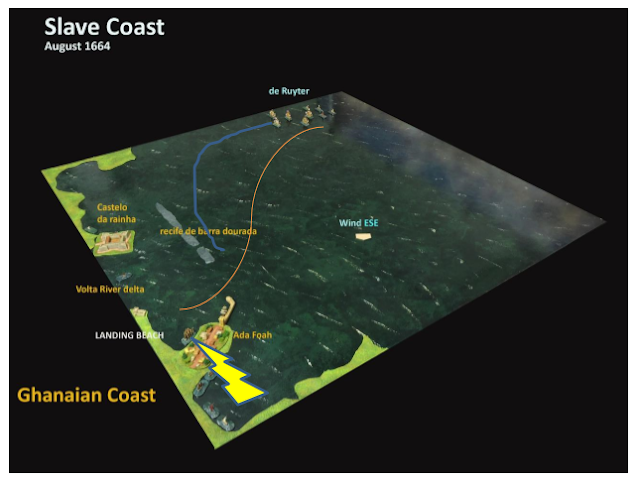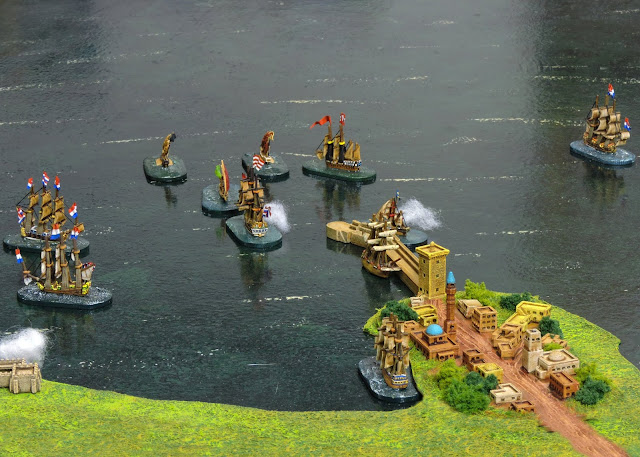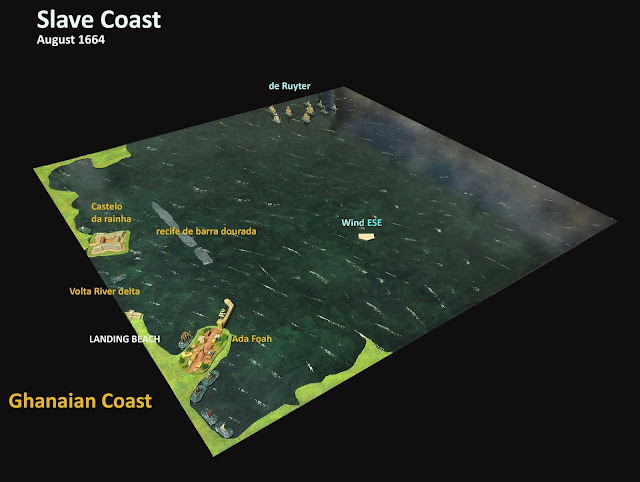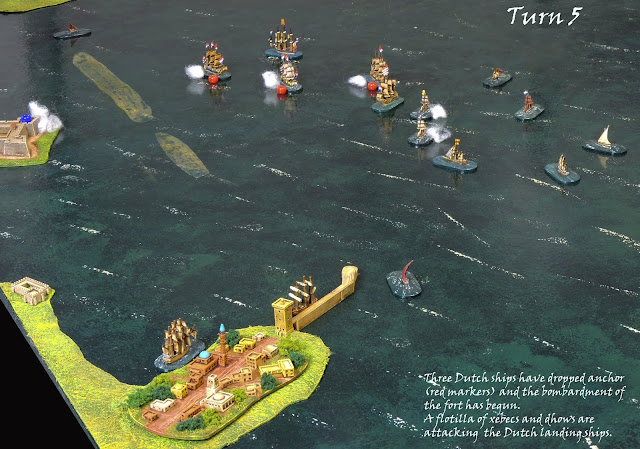I have been a bit remiss at not posting this campaign report sooner, but, it was a cracker and worth waiting for... Brilliant game, well played by both Dave and Colin.
 |
| The den of iniquity that is Adafoah - target of de Ruyter's squadron. |
Mouth of
the Volta River, Slave Coast. August 22nd,
1664
The mission to extinguish Arab
slaving activities operating from abandoned Portuguese facilities on the delta
of the Volta river in Western Africa was fraught with challenges from the
outset.
De Ruyter was charged by his
Admiralty with two unenviable objectives. The reduction by gunfire of an
extremely strong fort built fifty years previously by the Portuguese and, the
destruction by burning, of the bustling slaving town Adafoah, sited on a
headland opposite the fort and across the wide mouth of the Volta. His private
thoughts no doubt ran to wondering which idiot had conceived such a
hare-brained scheme.
 |
| The Dutch hug coast en route to Adafoah. |
The fort lay behind an enormous
silt bar across the mouth of the river the approach to which could only be
achieved via a narrow and dangerous channel. Access to Adafoah would be by
riding crashing breakers onto a sandy strand which ran from the river mouth
west, in a long curve toward the ramshackle town.
 |
| Peter's plan which Colin did his best to execute! |
De Ruyter knew that to fire the
town whilst suppressing the hostile denizens would require upwards of one
hundred and fifty men, well-armed and with the necessary combustibles. Landing
longboats on the beach would be challenging and losses even before landing were
highly probable therefore, additional resource had to be included in the
landing force to guarantee success and make good losses. This would inevitably
leave his battleships short of crews to repulse boarding attacks so beloved of
the slaver pirates.
 |
| Castel dan Rainha looms menacingly as the Dutch approach from the east. |
Castel da Rainha was another
proposition entirely. It went against the grain for an admiral such as de
Ruyter to drop anchor in dangerous shoals to engage a large and well-appointed
fortress with the purpose of reduction by gunfire. The amount of powder, shot,
time and weather-luck necessary for such a task was unquantifiable if the
garrison possessed backbone. The possibility of damage to his own ships was
significant. Sailing inshore to gain accuracy and impact would necessitate
negotiating an extremely narrow and hazardous tidal channel which even the
shallow-draught Dutch built ships would find problematic.
So, it came to pass that on August
22
nd, 1664 with much trepidation, de Ruyter divided his squadron
into two groups. The first, consisting five ships of the line;
Spiegel
70,
Klein Hollandia 56,
Provincie van Utrecht 56,
Geloof
50 and
Noorderkwartier 50, would sail inshore and anchor on the seaward
side of the fortress. Their combined firepower would, over a sustained period
reduce the fortress or, drive out the garrison.
 |
| Machgyel Adriensoon's Fleet |
Whilst this ambitious endeavour
was underway, the second group consisting of the small hoeker vessels
Groene
Kameel, Reijger and Oliphant, would sail into the anchorage and at 200
yards out, each release their two towed longboats containing thirty heavily
armed men apiece to burn Adafoah. These small ships were manned by Cape
colonist volunteers serving with the African fleet and the shore parties were
drawn from the crews of de Ruyter’s five warships. Accompanying the flotilla of
landing ships was a small burner, the
Drommedaris. Its purpose was to destroy
one of the large slavers at anchor in Adafoah harbour.
 |
| Turn 1 The Dutch approach |
Turns 1 – 5
The Dutch riding an onshore wind
wasted no time in moving towards their targets and the barrage on Castel da
Rainha commenced on Turn 5 with encouraging results. The fortress had already
opened fire on the incoming Dutch squadron at extreme range, perhaps to deter
any attack before it started.
Noorderkwartier scored early hits but as
the smoke accumulated and the fort retaliated, three significant impediments
became obvious to de Ruyter.
 |
| T3 - The Slaver's send out dhows and xebecs crammed with warriors to interdict the Dutch approach. |
Most of his ships had anchored cautiously far away
from the silt bar and so, were firing at extreme range. This, combined with the
relatively small calibre of the Dutch ordnance made scant impact on the massive
ramparts. Thirdly, the orientation of the fort relative to the silt barrier denied
all the warships a proper line of sight to the target. Progress was much slower
than anticipated and conditions at sea reduced the projected rate of fire
significantly.
 |
| T4 Battle is joined - Castel da Rainha opens fire on de Ruyter |
The small ships wasted no time in
lining up to drop their cargoes on the beach but no sooner had they began their
approach drawing close to the mole of Adafoah harbour, when a group of dhows
emerged from various points and converged on the leading Dutch ships. These
small boats without guns, were crammed with Arab warriors bent on boarding and
killing the Dutchmen. Two armed xebecs joined the defence and a confusing
battle of little ships commenced.
 |
| T4 The Dutch approach the massive silt bar |
The lead Dutch ship
Reijger
delivered lucky but productive fire against a sleek xebec
Aljana which
promptly exploded in the centre of the channel and disappeared.
Notwithstanding,
Reijger was attacked by other boats as was
Groene
Kameel and
Oliphant.
 |
| T6 Aljana's powder store explodes. Red markers - at anchor. Blue - reload. |
All too soon two Dutch ships were captured,
their crews killed or thrown over the side and their longboats holed and sunk.
Only
Groene Kameel which had fought hard with the crew of the large dhow
Afriqiaan was able to disengage and head back toward the anchored
warships. Her shore parties had been all but wiped out in the fight and the
ship was barely seaworthy as it retreated.
 |
| T8 - The Great Admiral rides the silt bar! |
In a matter of forty minutes almost all
de Ruyter’s invasion force was destroyed and its transports sunk or captured.
Only the burner remained and picked its way gingerly through the carnage
dodging marauding dhows and gunfire to slip under the mole and into the
harbour.
 |
| The Hollywood shot! Spiegel makes the inshore waters and the Volta mouth |
The slavers demonstrated great
courage as several small dhows prosecuted attacks on the large anchored
warships bombarding the fortress. A small dhow
Mawah, succeeded in
grappling and boarding
Geloof before finally being overpowered and sunk.
The
Muhit which had captured and then deliberately sunk
Oliphant,
later boarded the much larger
Provincie van Utrecht before its men were
overwhelmed and wiped out.
 |
| T9. The Slaver Fleet begins to arrive in the bottom right hand corner - is de Ruyter trapped inshore? |
As this bloody hand to hand and
ship on ship duelling played out, sails were spotted approaching from the west
and hugging the coast. Five Berber ocean-going warships hove into view and de
Ruyter knew he now had an extremely serious situation on his hands. Lack of
progress in reducing the fort provoked the reckless bravery for which the
legendary admiral was rightly famous.
 |
| T10.Desperate times for the Dutch. |
Astonishing not only the enemy but his
own fleet,
Spiegel weighed anchor and sailed directly for the great silt
bar under the very muzzles of the fort. Two boat loads of soldiers had been
retained as a reserve aboard the flagship. In a demonstration of sublime
seamanship,
Spiegel rode over the silt bar with her keel scraping a
trail in the mud and reached the clear water off the breaker beach. Even the
Berbers applauded!
 |
| T11 Boats away! De Ruyter sends in his own crewmen and soldiers only to be greeted by the hidden fort. |
Dropping anchor as far inshore as
possible, two boats were lowered each containing thirty men. As these prepared
to ride the massive white topped breakers crashing onto the shore, cannon fire
erupted from a previously unseen low walled adobe fort just behind the beach. A
lucky shot smashed into one of the boats which capsized in the rolling waves.
De Ruyter from his inshore position could see that the arrival of the Arab war
fleet meant his own flagship was now potentially hemmed into the harbour.
Agonizingly, he gave the order to abandon his remaining longboat to its fate as
he frantically tried to fight his way out to sea.
 |
| T12. Fighting out of the jaws of the trap - ASpiegel rams her way to open water. |
As this drama played out the
stealthy progress of
Drommedaris had gained the perfect position to run
against an anchored slaver. Her captain ordered her fired and she promptly
exploded in the centre of the harbour. The eruption was so violent that three
proximate dhows, recently victorious against the landing force, were blown to
pieces. Flaming wreckage even landed on
Spiegel several hundred yards
inshore
.
 |
| T13 - To the rescue - Rally on the Admiral! The Dutch cavalry arrive in the nick of time |
Turns 13-16
All the Dutch captains had spotted
the peril of their admiral. Every warship weighed anchor and made sail for the
harbour mouth to hold back the fast approaching enemy and clear a path for
Spiegel
to escape. Two war galleys newly arrived, lined up an attack to board de
Ruyter’s ship. The admiral met the attack and at the head of his men he
captured the
Barbry. In doing so he sustained a bloody sword cut to his
chest.
Noorderkwartier had arrived and she boarded and captured another
galley,
Tajir. Gunfire from
Geloof and
Provincie van Utrecht
accounted for two more xebecs
Eisafa and
Eabd. The former crashed
into the mole’s outer wall and was then sunk by gunfire at 20 yards from
Spiegel
as she finally cleared the harbour. The latter was completely dismasted and
drifted into the tangled wreckage in the anchorage. This flurry of intense
destruction left a single Berber vessel operational. The large European built
galleon
Firewan was strong enough to deter a concerted effort to
overcome her yet not able to match the numerous Dutch vessels. She stood off
and de Ruyter extricated his five warships from the smoking, wreck filled
anchorage of Adafoah.
 |
| T16 Game end - The Slaver fleet is destroyed but the mission is a failure |
Despite the capture of two galleys
and the destruction of four dhows and four xebecs, the attack on Adafoah was a
failure. De Ruyter lost three small ships, all his pinnaces, nearly 180
seasoned sailors and soldiers and a further 55 men aboard the warships. Castel
da Rainha was not significantly reduced and Adafoah continued to trade freely
in its human cargo and ivory.
De Ruyter’s squadron, almost out of
powder and shot, short of water, undermanned and somewhat demoralized, set
course southward to replenish at the nearest VOC station and make all the
necessary provision and repair to stay operational.



















